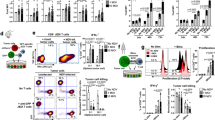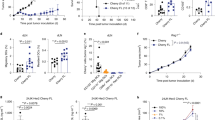Abstract
Dendritic cells (DC) perform an important role in the initiation of the immune response through the local secretion of inflammatory mediators within diseased tissue in response to Toll-like receptor (TLR) ligation. However, DC vaccine strategies fail to make use of this capability against cancer. To harness the TLR response capability of DC against cancer, we tested a series of recombinant genes for their ability to redirect DC function specifically against a tumor-associated antigen. Each gene encoded a cell surface chimeric protein made up of extracellular single-chain immunoglobulin anti-erbB2 linked to an intracellular TLR-signaling component composed of either myeloid differentiation factor 88, interleukin-1 receptor-associated kinase-1 (IRAK-1) or the cytoplasmic domain of TLR4. Each gene was expressed in the DC line, JAWS II, to a similar degree following retroviral transduction. However, only the chimera containing IRAK-1 was able to mediate interleukin-12 and tumor necrosis factor-α secretion. Since TLR engagement can also activate DC and enhance their ability to stimulate T cells, we ligated the chimeric anti-erbB2-IRAK-1 receptor and determined the effect on the stimulation of T cells. We found that JAWS II cells triggered through chimeric anti-erbB2-IRAK-1 displayed an enhanced ability to stimulate ovalbumin-specific OT-II CD4+ T cells. This first description of the generation of tumor-reactive DC may lead to the development of new cell-based vaccines that can act at both the tumor site to induce danger and at the lymph node to stimulate a specific T-cell response.
This is a preview of subscription content, access via your institution
Access options
Subscribe to this journal
Receive 12 print issues and online access
$259.00 per year
only $21.58 per issue
Buy this article
- Purchase on Springer Link
- Instant access to full article PDF
Prices may be subject to local taxes which are calculated during checkout






Similar content being viewed by others
References
Rosenberg SA . Progress in human tumour immunology and immunotherapy. Nature 2001; 411: 380–384.
Banchereau J, Palucka AK . Dendritic cells as therapeutic vaccines against cancer. Nat Rev Immunol 2005; 5: 296–306.
Eisenberger A, Elliott BM, Kaufman HL . Viral vaccines for cancer immunotherapy. Hematol Oncol Clin North Am 2006; 20: 661–687.
Rosenberg SA, Sherry RM, Morton KE, Scharfman WJ, Yang JC, Topalian SL et al. Tumor progression can occur despite the induction of very high levels of self/tumor antigen-specific CD8+ T cells in patients with melanoma. J Immunol 2005; 175: 6169–6176.
Rosenberg SA, Yang JC, Restifo NP . Cancer immunotherapy: moving beyond current vaccines. Nat Med 2004; 10: 909–915.
Pockaj BA, Sherry RM, Wei JP, Yannelli JR, Carter CS, Leitman SF et al. Localization of 111indium-labeled tumor infiltrating lymphocytes to tumor in patients receiving adoptive immunotherapy. Augmentation with cyclophosphamide and correlation with response. Cancer 1994; 73: 1731–1737.
Petrulio CA, Kim-Schulze S, Kaufman HL . The tumour microenvironment and implications for cancer immunotherapy. Expert Opin Biol Ther 2006; 6: 671–684.
Matzinger P . Tolerance, danger, and the extended family. Annu Rev Immunol 1994; 12: 991–1045.
Kawai T, Akira S . Pathogen recognition with Toll-like receptors. Curr Opin Immunol 2005; 17: 338–344.
Pandey S, Agrawal DK . Immunobiology of Toll-like receptors: emerging trends. Immunol Cell Biol 2006; 84: 333–341.
Takeda K, Kaisho T, Akira S . Toll-like receptors. Annu Rev Immunol 2003; 21: 335–376.
O'Neill LA . How Toll-like receptors signal: what we know and what we don't know. Curr Opin Immunol 2006; 18: 3–9.
Brightbill HD, Modlin RL . Toll-like receptors: molecular mechanisms of the mammalian immune response. Immunology 2000; 101: 1–10.
Hoshino K, Takeuchi O, Kawai T, Sanjo H, Ogawa T, Takeda Y et al. Cutting edge: Toll-like receptor 4 (TLR4)-deficient mice are hyporesponsive to lipopolysaccharide: evidence for TLR4 as the Lps gene product. J Immunol 1999; 162: 3749–3752.
Medzhitov R, Preston-Hurlburt P, Janeway Jr CA . A human homologue of the Drosophila Toll protein signals activation of adaptive immunity. Nature 1997; 388: 394–397.
Ozinsky A, Underhill DM, Fontenot JD, Hajjar AM, Smith KD, Wilson CB et al. The repertoire for pattern recognition of pathogens by the innate immune system is defined by cooperation between toll-like receptors. Proc Natl Acad Sci USA 2000; 97: 13766–13771.
Furumoto K, Soares L, Engleman EG, Merad M . Induction of potent antitumor immunity by in situ targeting of intratumoral DCs. J Clin Invest 2004; 113: 774–783.
Chicoine MR, Won EK, Zahner MC . Intratumoral injection of lipopolysaccharide causes regression of subcutaneously implanted mouse glioblastoma multiforme. Neurosurgery 2001; 48: 607–614; discussion 614–605.
Brin E, Atencio I, Helmich BK, Maneval D, Laface D . Adenovirus delivery provides extended interferon-alpha exposure and augments treatment of metastatic carcinoma. Cancer Gene Ther 2006; 13: 664–675.
Chikkanna-Gowda CP, Sheahan BJ, Fleeton MN, Atkins GJ . Regression of mouse tumours and inhibition of metastases following administration of a Semliki Forest virus vector with enhanced expression of IL-12. Gene Therapy 2005; 12: 1253–1263.
Hart DN . Dendritic cells: unique leukocyte populations which control the primary immune response. Blood 1997; 90: 3245–3287.
Sandel MH, Dadabayev AR, Menon AG, Morreau H, Melief CJ, Offringa R et al. Prognostic value of tumor-infiltrating dendritic cells in colorectal cancer: role of maturation status and intratumoral localization. Clin Cancer Res 2005; 11: 2576–2582.
Banchereau J, Briere F, Caux C, Davoust J, Lebecque S, Liu YJ et al. Immunobiology of dendritic cells. Annu Rev Immunol 2000; 18: 767–811.
Cooper LJ, Topp MS, Serrano LM, Gonzalez S, Chang WC, Naranjo A et al. T-cell clones can be rendered specific for CD19: toward the selective augmentation of the graft-versus-B-lineage leukemia effect. Blood 2003; 101: 1637–1644.
Gilham DE, O'Neil A, Hughes C, Guest RD, Kirillova N, Lehane M et al. Primary polyclonal human T lymphocytes targeted to carcino-embryonic antigens and neural cell adhesion molecule tumor antigens by CD3zeta-based chimeric immune receptors. J Immunother 2002; 25: 139–151.
Haynes NM, Trapani JA, Teng MW, Jackson JT, Cerruti L, Jane SM et al. Single-chain antigen recognition receptors that costimulate potent rejection of established experimental tumors. Blood 2002; 100: 3155–3163.
Hwu P, Yang JC, Cowherd R, Treisman J, Shafer GE, Eshhar Z et al. In vivo antitumor activity of T cells redirected with chimeric antibody/T-cell receptor genes. Cancer Res 1995; 55: 3369–3373.
Kershaw MH, Westwood JA, Hwu P . Dual-specific T cells combine proliferation and antitumor activity. Nat Biotechnol 2002; 20: 1221–1227.
Ma Q, Safar M, Holmes E, Wang Y, Boynton AL, Junghans RP . Anti-prostate specific membrane antigen designer T cells for prostate cancer therapy. Prostate 2004; 61: 12–25.
Lamers CH, Gratama JW, Pouw NM, Langeveld SC, Krimpen BA, Kraan J et al. Parallel detection of transduced T lymphocytes after immunogene therapy of renal cell cancer by flow cytometry and real-time polymerase chain reaction: implications for loss of transgene expression. Hum Gene Ther 2005; 16: 1452–1462.
Sloan JM, Kershaw MH, Touloukian CE, Lapointe R, Robbins PF, Restifo NP et al. MHC class I and class II presentation of tumor antigen in retrovirally and adenovirally transduced dendritic cells. Cancer Gene Ther 2002; 9: 946–950.
Perera PY, Mayadas TN, Takeuchi O, Akira S, Zaks-Zilberman M, Goyert SM et al. CD11b/CD18 acts in concert with CD14 and Toll-like receptor (TLR) 4 to elicit full lipopolysaccharide and taxol-inducible gene expression. J Immunol 2001; 166: 574–581.
Butz EA, Bevan MJ . Differential presentation of the same MHC class I epitopes by fibroblasts and dendritic cells. J Immunol 1998; 160: 2139–2144.
Bendelac A, Medzhitov R . Adjuvants of immunity: harnessing innate immunity to promote adaptive immunity. J Exp Med 2002; 195: F19–F23.
Schwarz K, Storni T, Manolova V, Didierlaurent A, Sirard JC, Rothlisberger P et al. Role of Toll-like receptors in costimulating cytotoxic T cell responses. Eur J Immunol 2003; 33: 1465–1470.
Acknowledgements
This work was supported by grants from the National Health and Medical Research Council of Australia (NHMRC), the Cancer Council of Australia, the Bob Parker Memorial Trust and the Peter MacCallum Cancer Centre Foundation. MK is supported by a Career Development Award from the National Breast Cancer Foundation and NHMRC. PD is supported by an RD Wright Fellowship, NHMRC. YX is supported by a Peter Doherty Postdoctoral Fellowship from the NHMRC.
Author information
Authors and Affiliations
Corresponding author
Additional information
YX designed, performed the research and analyzed data; PD contributed vital new reagents; MK designed the research and wrote the paper.
Rights and permissions
About this article
Cite this article
Xu, Y., Darcy, P. & Kershaw, M. Tumor-specific dendritic cells generated by genetic redirection of Toll-like receptor signaling against the tumor-associated antigen, erbB2. Cancer Gene Ther 14, 773–780 (2007). https://doi.org/10.1038/sj.cgt.7701073
Received:
Revised:
Accepted:
Published:
Issue Date:
DOI: https://doi.org/10.1038/sj.cgt.7701073
Keywords
This article is cited by
-
Lentiviral Vectors in Gene Therapy: Their Current Status and Future Potential
Archivum Immunologiae et Therapiae Experimentalis (2010)



